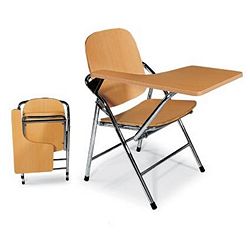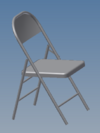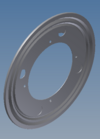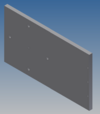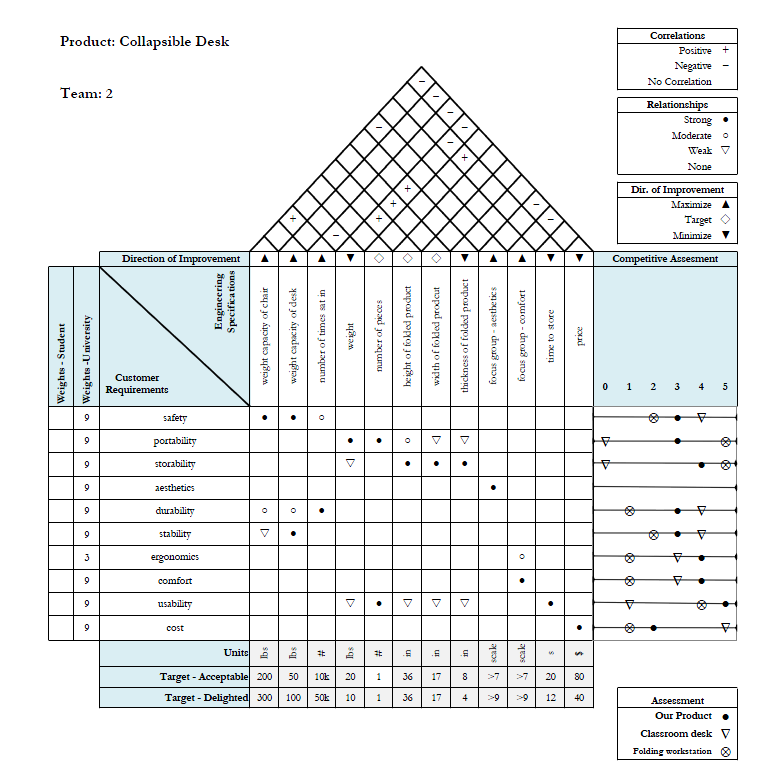Folding Desk Chair Innovation
From DDL Wiki
(→Cost) |
(→Cost) |
||
| Line 56: | Line 56: | ||
| - | {| | + | {|border="1" cellpadding="5" |
|- | |- | ||
! Component | ! Component | ||
Revision as of 00:41, 7 May 2012
Contents |
Executive Summary
Market Analysis
Relevant Market Research
Survey
During our market research phase we conducted a survey and received 72 responses. We collected a lot of useful information from this survey; the details most relevant to our final concept are highlighted below.
One of the questions asked was how many times a week the individual uses a folding chair. The most common responses were less than once a week and 1 to 4 times a week, leading us to believe that the respondents use folding chairs for a specific purpose. We concluded that the best approach was to focus on developments that improve a specific experience, rather than focus on a more general folding chair concept that could serve multiple functions. In the case of our final concept, the collapsible desk, we have improved the experience of working in a small on-campus room that may not have a traditional desk.
The respondents were also asked to rate the importance of various characteristics of a folding chair on a scale of 1 (least important) to 5 (most important). Based on the data gathered from this section, we were able to identify the characteristics that consumers look for in folding chairs, and were better able to incorporate these features into our design. The top five characteristics, as seen in the chart below, were comfort, portability, durability, weight, and storage. Since the whole idea of our collapsible desk hinges on adding more features to a standard folding chair, we had to make some sacrifices in terms of portability and weight. However, the comfort and storage elements are addressed very well by our design; the chair features comfortable upholstery to make working more pleasant, and the desk element folds neatly into the same footprint as the back of the folded chair, making the storage of our product no more difficult than that of a standard folding chair.
It was with the open-ended questions at the end of the survey that we got the most interesting and useful responses. When asked what they felt was lacking in folding chairs, the consumers responded with requests for a table surface:
- “Desk attachment. Sort of like in lecture halls so you can sit a laptop or book on it.” – Anonymous Male, 18
- “Attachable, sturdy table for eating and reading on (for instance, at the beach)” – Anonymous Female, 19
This consumer feedback contributed to our decision to pursue the option of developing a folding desk. The survey answers not only showed us that a folding desk would be a popular product, but also identified the target market that would be most likely to purchase it; young university students.
Retailer Interview
In addition to a consumer survey, we conducted a retailer interview to see what information we could gather from those who will most likely be interacting with the consumer in order to sell the product. While most of the information gathered is not directly relevant to our product, a Target employee was able to tell us more about consumer behavior when it comes to purchasing the folding chairs that they had in stock. We chose the most popular folding chair, as identified by the Target employee, to use as the base for our prototype folding desk. She was also able to tell us that the most expensive folding chair they had in stock was often used as a desk chair by students. We concluded that if students are willing to pay more for a nice desk chair, they are more likely to be interested in a quality chair that also doubles as a desk.
Prototype User Study
Other Market Research
Aside from the market research detailed above, we conducted individual and group user studies during our research phase. However, while these helped us gain a good sense of how consumers transport, set up, and use folding chairs, they are not the most relevant studies to the final concept we settled on, and so will not be discussed in great detail in this report.
Competitor Products
Cosco Upholstered Folding Chair
Aside from the market research detailed above, we conducted individual and group user studies during our research phase. However, while these helped us gain a good sense of how consumers transport, set up, and use folding chairs, they are not the most relevant studies to the final concept we settled on, and so will not be discussed in great detail in this report.
Folding Workstation
This product is a sleek, lightweight desk that folds when not in use. While this product has a very small storage footprint, it is still just a desk; the user will also need to purchase and store a separate chair in order to fully use the workstation. Even if this chair also folds up for easier storage, it introduces more complexity for the user since there are two unconnected parts making up the full set.
Chair with Writing Tablet
Desks like these are staples in smaller university classrooms. They are composed of simple chairs (usually plastic) that have a small desk surface supported by an arm on one side. While these chairs are relatively easy to move from classroom to classroom compared to chairs with larger desks, they are not as portable as folding chairs and have a very small desk surface.
Folding Chair with Writing Tablet
The folding chair with attached tablet is the competitor product that is most similar to our final concept, and is essentially a folding version of the above competitor product. It comes out ahead of the non-folding classroom desk since it is much easier to transport and store. However, there are some notable flaws which our product is able to successfully resolve. For instance, the desk for this competitor product folds in front so that the product cannot be used as just a chair, the product boasts a much smaller desk area than our design, and it can only be ordered in bulk. Our design will be much more available and appealing to the individual college student for all of these reasons.
Target Market
Our target market is the student population in a university setting or similar. Those who live in campus dorms or small off-campus housing usually do not have much space. Many do not have room for a desk, and struggle to do their work on beds or normal chairs. This desk can easily be stored under a bed or in a closet when not in use, and can be pulled out quickly when work needs to be done.
Price, Cost, & Profitability
Price
The wholesale pricing of our folding desk competitor is $56.83. Since our product will not be sold wholesale, the price will be set higher than this in order to make a profit. Based on this information, and our conclusions from our House of Quality analysis, we have decided to set the price at $80. We believe that this is a reasonable price for our product. It is more expensive than the competitor folding chair, but the advantages of individual purchase, larger desk space, and the ability to use it solely as a chair make it a more competitive product. Since traditional desks and chairs would run much higher costs than $80, we believe that students would be willing to pay this price for a space-saving desk with a large surface area.
Cost
For our cost and profitability analysis we first needed to estimate the annual production quantity for our product. The supplier of one of our competitor products (the folding chair with tablet) is able to supply about 2,000 units a month, which equals 24,000 units a year. Since these are only available wholesale, and we will aiming at the individual consumer market, we think it is reasonable to assume that our production level will be slightly lower than this. We will estimate a production run of approximately 20,000 units a year.
Using this estimate, the individual costs of the most important components were calculated in order to find the total cost of producing a complete unit.
| Component | Cost ($) |
|---|---|
| Chair | 25.10 |
| Desk Surface | 15.45 |
| Supporting Plate | 8.11 |
| Desk Arm | 2.20 |
| Hinge | 4.25 |
| Total | 55.11 |
Profitability
Design Documentation
Bill of Materials
House of Quality
Design Analysis
DFMA
Design for Manufacture and Assembly considerations were significant to the prototype and design analysis. As the DFMA implications are expanded to the large scale production regime, several conclusions become apparent. If implemented on a large scale, the folding desk chair would be composed of two major subassemblies: a stock folding chair (likely very similar to the black Target brand model used in our physical prototype), and the custom desk and arm sub assembly. This means that other than the simple variations made to the folding chair (holes to mount hardware) after assembly in its own factory, all DFMA considerations for this project lie in the desk, arm and hinge sub assembly. Even on the large scale, we would have little to no control over DFMA in the chair.
The following is a description of some of the major DFMA considerations made for our prototype and hypothetical production-scale model. Firstly, stock tubing is used to form the main pivot arm. In this and all cases, use of fasteners is minimized by using as few parts as possible. In this example, bending stock tubing is the simplest way to make the custom shape of the arm. Attaching the main arm to to the chair and hinge on each end is also done using DFMA considerations, by using rivets and spring pins rather than traditional fasteners. This is because fasteners such as rivets and pins are easier to install, cheaper, and their inherent drawback of permanency doesn't matter in this use. Once the chair is assembled, it need not be disassembled. The hinge that allows the desk to open and close is a unique shape, but still only composed of two folded sheet metal pieces hinging on rivets. The interface between the support arm and the hinge is also hinged using a rivet, which is strong and easy to manufacture.
FMEA
Failure Mode Effects Analysis was the largest and most important aspect of the Design Analysis facet. In order to customize the analysis to our design, the group focused on the failure individual components, and how this would affect the functionality or safety of the overall product. For example, many instances of yielding or joints locking up results in the user being unable to open or close the chair, which is a significant concern.
DFE
To further analyze the competitiveness of our design solution, we conducted an economic input-output life cycle analysis of our product. Once again, after initial analysis, we found that the majority of the environmental impact of our product is the result of the production and manufacturing phase. Thus we chose several sectors that best represented our product. Once again we had the retail price of the chair. For the pricing of the additional new parts we either used resources such as McMaster-Carr or custompart.net to estimate a cost. Using all this data we ran a new EIO-LCA the results of which can seen below.
Once again, we found that the total CO2 tax would be less than 2% of the cost of the product. Not only is this insignificant in terms of our current product, but it is also about the same as our original folding chair, meaning that it is equivalent to what is on the market today.
| Production | ||||
|---|---|---|---|---|
| Chair | Desk Arm | Hardware | Desk Surface | |
| Sector | 33712A Metal and other household unupholstered furniture | 332996 Fabricated pipe and pipe fitting manufacturing | 332500 Hardware manufacturing | 32619A Other plastics product manufacturing |
| MTCO2E per $1M | 613 | 796 | 600 | 748 |
| Unit | chair | arm | hardware | desk surface |
| Unit per lifetime | 1 | 1 | 1 | 1 |
| Cost per unit | $32.38 | $2.20 | $12.36 | $15.45 |
| Lifetime | $32.38 | $2.20 | $12.36 | $15.45 |
| Implied MTCO2E | 0.01984894 | 0.0017512 | 0.007416 | 0.0115566 |
| CO2 tax @$30/mt | $0.60 | $0.05 | $0.22 | $0.35 |
Mechanical Analysis
Due to the drawbacks with modeling and analyzing thin-walled parts with modern CAD software, computer analyses of the entire model were not possible. However, this forced the group to hone in on important systems within the full assembly, also highlighting the effects of specific, local design changes rather than glossing over details in the results from a single comprehensive (and complex) analysis. Important analyses done using CAD software were stress analysis in the desktop and WHAT ELSE?
The results are shown in the appendix.
Separate from the computer-based simulations done, some simple rigid-body statics were performed to determine tipping points and safe loads on the desk surface with and without a user sitting in the chair. This was also a place that the group determined that desk legs were not required for safe operation, combined with other considerations like weight and (lack of) convenience.
Prototype Documentation
Our prototype is overall fairly representative of the hypothetical mass-produced product. The only major difference is the desk surface, which is stiff plastic as opposed to the plywood on our prototype. Otherwise, all of the parts used in our prototype are decisively manufactureable or stock, and would change little in the large scale.
Smaller differences present between the two models stem from our lack of ability to weld. The axle and bearings that facilitate the desk rotation in our prototype are a substitute for an equally strong but much simpler (and lighter) pin connection.
Another minor difference is the mechanism for holding the desk in its open position. In the prototype, a chain measured to a length becomes taut at when the correct angle between the front leg of the chair and the desk support arm is reached. The chain is only a few inches long, and is connected to the aforementioned limbs a few inches above the arm's axis of rotation. However, our mass-production model will facilitate the dynamics using elbow links (in the same place as the chain), which are easy to assemble, more durable than a chain, and arguably more aesthetic.
Very minor differences include the specific hardware for stopping the desk when it is put away, and nuanced use of rivets in place of other fasteners.
Design Process
As our group moved towards the final design stages, our roles became a productive balance of both dynamic tasks and distinct responsibilities. Sarah's role as team leader resulted in frequent but efficient meetings, consistent reminder of the big picture and effective weekly task delegation. Similarly, although Joseph led the prototype and CAD sections, whenever the group was in either the machine shop or the computer lab, tasks were delegated and all members worked efficiently in parallel. Not only was this an effective use of brainpower and time, but it also ensured that all members stayed actively involved in the product across the entire semester. The transition between Will and Sarah as team leader was politically tumultuous, but resulted in a more well rounded representation of different thoughts in the group. Will continued to be very organized (keeping track of class handouts) and an active participator in weekly meetings with the professor, as well as hosting many of our meetings in his own dormitory. Tammy was in charge of most of the design analysis parts of the project. Being the best at CAD, she led the transition between accurately modeling the chair on a visual basis to making a viable model to simulate with. Despite working alone while actually running simulations, she always reported back to the group with concerns and results, which were met with feedback from the rest of the group. Mark was supportive in all of our endeavors, often filling in under odd jobs. He purchased many of the items, taking responsibility for the finances with the university.
Lastly, an important part of our team dynamic this semester was using the group texting application, GroupMe. Set up at the beginning of the semester, it has continued to be our only resource for the necessary quick and accessible communication we did, and is much less cumbersome than long email chains.


